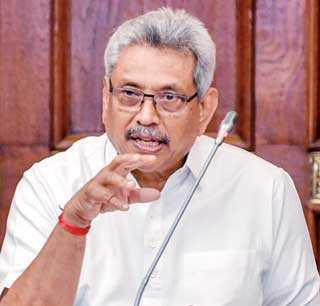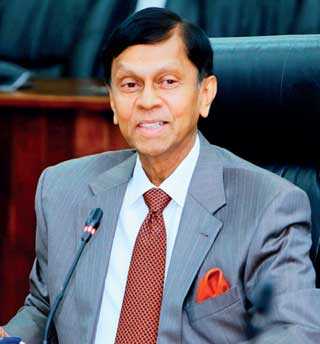Thursday Nov 14, 2024
Thursday Nov 14, 2024
Friday, 11 December 2020 00:00 - - {{hitsCtrl.values.hits}}
 |
| President Gotabaya Rajapaksa |
 |
| Prime Minister and Finance Minister Mahinda Rajapaksa |
 |
| State Minister of Money, Capital Market and Public Enterprise Reform Nivard Cabraal
|
Global financial giant Citi has cautioned Sri Lanka that its denial of a debt crisis shouldn’t be a strategy, and called for effective restructuring and boosting of income streams.
In a latest assessment, ‘Sri Lanka Economics and Strategy View,’ Citi Research said Sri Lanka’s debt was on an unsustainable path, but the Government appeared to be in denial.
“While officials continue to mention their willingness to pay, we cannot see a credible strategy for achieving debt sustainability and (external) repayment capacity beyond talking up their growth prospects and expecting this to attract FDI and other portfolio equity inflows,” the research document said.
“The ability of financial repression to contain domestic borrowing costs is limited by rising debt ratios, still expected to grow amid a pro-growth 2021 Budget. We expect net FDI will finance about 40% of the current account deficit in 2021F, and the rest will not be wholly covered by official multilateral and bilateral lending, let alone commercial funding, in the absence of an IMF policy reform backstop,” Citi said.
It also expects reserves will fall to uncomfortable levels after the July 2021 is repaid but they may still muddle through next year. “We estimate gross FX reserves of $ 5.86 billion in Oct is enough to cover about 55% of total external financing requirements,” Citi said.
Noting capital and import controls had helped slow the pace of reserve decline, Citi said the Rupee did not look grossly misaligned. “If we assume short-term debt and official loans are rolled over, and China lends an additional $800 million to Sri Lanka in 2021, reserves should fall to $ 3.7 billion in end of 2021 giving them room to muddle through next year. Any shortfalls in rollovers and Chinese financing, and reserves would fall more sharply,” warned Citi Research.
In its view a Sri Lanka debt restructuring may not happen until 2022: “The Government’s willingness to pay is high, and we do not expect an aggressive principal reduction. We expect the Government will pay the July 21s and possibly the January 22s (though the latter is less certain).”
The Citi Research also presented two scenarios. “In our base case we assume Sri Lanka’s Government will be compelled to engage with the IMF to execute the restructuring. We expect a coupon haircut of around 52% to stabilise the debt at current levels, with maturity extensions three to five years across the curve,” it said.
“We also assess a scenario in which Sri Lanka does not engage with the IMF due to policy differences with the Fund. In this case, a successful restructuring would be difficult and exit yields would be significantly higher than the 10-11 %, one would see in other countries with an IMF program,” Citi Research added.
“We remain cautious on Sri Lanka bonds as the road to restructuring is long. We do not recommend getting involved in Sri Lanka bonds given the Government’s lack of a debt repayment strategy and the uncertainties around the government’s willingness to engage with the IMF. Our NPV analysis suggests further downside,” Citi said.
The Citi Research in its report also looks at Debt Stock and Flow Analysis - Why Restructuring Looks Inevitable; Pool of Debt for Restructuring; Sovereign Haircut Scenarios; and Potential Restructuring Scenarios.
In its detailed commentary Citi Research said perhaps the one saving grace for bondholders, especially the ones with more immediate maturity, was that the Sri Lankan Government had publicly reiterated that the Government had no plans to default and had never defaulted.
“This could lead to two offsetting outcomes – on the one hand, they may maintain their current optimism for longer than is rational, which will help short-dated bonds to the detriment of longer-dated ones; and second, when there is a restructuring event, they may attempt not to be excessively punitive and may try to distribute the pain across other stakeholders, particularly taxpayers and domestic investors already held captive through capital controls,” it said.
“But we do not see a credible strategy from the Government to achieve sustained debt repayment capacity despite their verbal ‘willingness’. We see Government actions to date as acting more as though they are in a liquidity and not a solvency crisis, and have the same flexibility to pursue MMT as developed economies (we think they will be constrained by external liquidity and eventually inflationary pressures), and we note that they have not yet outlined a strategy to reduce debt ratio to sustainable levels beyond talking up their growth prospects,” Citi Research opined.
To defend its repayment capacity, it said the Lankan Government was focusing on new borrowing (e.g. additional $ 700 m of COB facility) to cover maturities ($ 1 b sovereign bond) – in a very piecemeal approach – bond by bond.
“This is unlikely to be enough to restore investor confidence, not to mention that there is a time delay to negotiating the new financing (e.g. the $ 700 m of CDB loans has been talked about since May, and has not yet been disbursed).”
Citi Research also thinks the 2021 Budget does not meaningfully address the need to reduce debt, and has pushed back consolidation to future years, primarily relying on growth and financial repression to get them there – a highly risky approach.
The 2021 F Budget is forecast at 8.9% of GDP budget deficit (4% primary deficit) with real GDP growth pegged at 5.5% versus consensus forecast at +3.2%. Fitch downgraded Sri Lanka’s rating to CCC shortly not long after the Budget, in line with Citi’s expectations.
“We see no viable external financing strategy beyond 2021 F as reserves fall to alarmingly low levels. We estimate FX reserves will fall below the $ 4 b psychological threshold by July coinciding with the sovereign bond maturity assuming no extraordinary new financing (and we suspect this could push the Government back to the IMF).
“The only strategy laid out on the external front is for FDI to pick up in 2021 on the back of Colombo Port City and Hambantota Industrial Zone projects, mobilising foreign inflows through stock listings, and maintaining a relatively low current account deficit (though wider than 2020F), while trying to ‘utilise domestic resources to finance a large part of the budget deficit… to limit the increase in the foreign debt stock’. The latter would imply running down FX reserves.”
After FDI declined 35%YoY in 1H20, Citi expects net FDI will not exceed 40% of the CAD in 2021 F, nor can they mobilise foreign inflows into local Treasury securities on a hedged and HTM basis, as the dollar bonds offer much higher yield and liquidity. “It is unclear how much loans from China can be secured to replace the global sovereign bonds, but given the slow disbursal this year, we expect net new China financing won’t accelerate next year,” Citi said.
It said interest burden on outstanding debt stock was unsustainably high: “Sri Lanka’s debt stock is high and rising, hitting about 102.5% of GDP in August 2020 if guaranteed debt and obligations to the IMF are included. The lack of global bond market access has forced the Government to increasingly shift to domestic sources of financing, with domestic debt now accounting for 54% of total Government debt, up from 51% in 2019.
“While CBSL has cut reserve requirements by 300 bps and policy rates by 200bps year to date, bringing average interest cost on new domestic debt down relative to previous years, overall interest expense is still up 9% in Jan-Aug yoy as the interest cost of domestic debt remains substantially higher than the outstanding stock of foreign debt, where about 44% of foreign debt is still concessional (the Government hasn’t issued dollar bonds since June 2019).
“We estimate interest expense at about 6.4% of GDP is now at a historic high and is a full 1.3% of GDP higher than at the start of the last IMF program. Meanwhile, revenues have fallen by 26% YoY, such that interest expense accounts for an unsustainable 72.1 % of total revenues as of August ytd. Alongside the need for significant revenue improvement, we think a coupon haircut is likely to bring the overall debt burden substantially lower,” Citi Research added.
